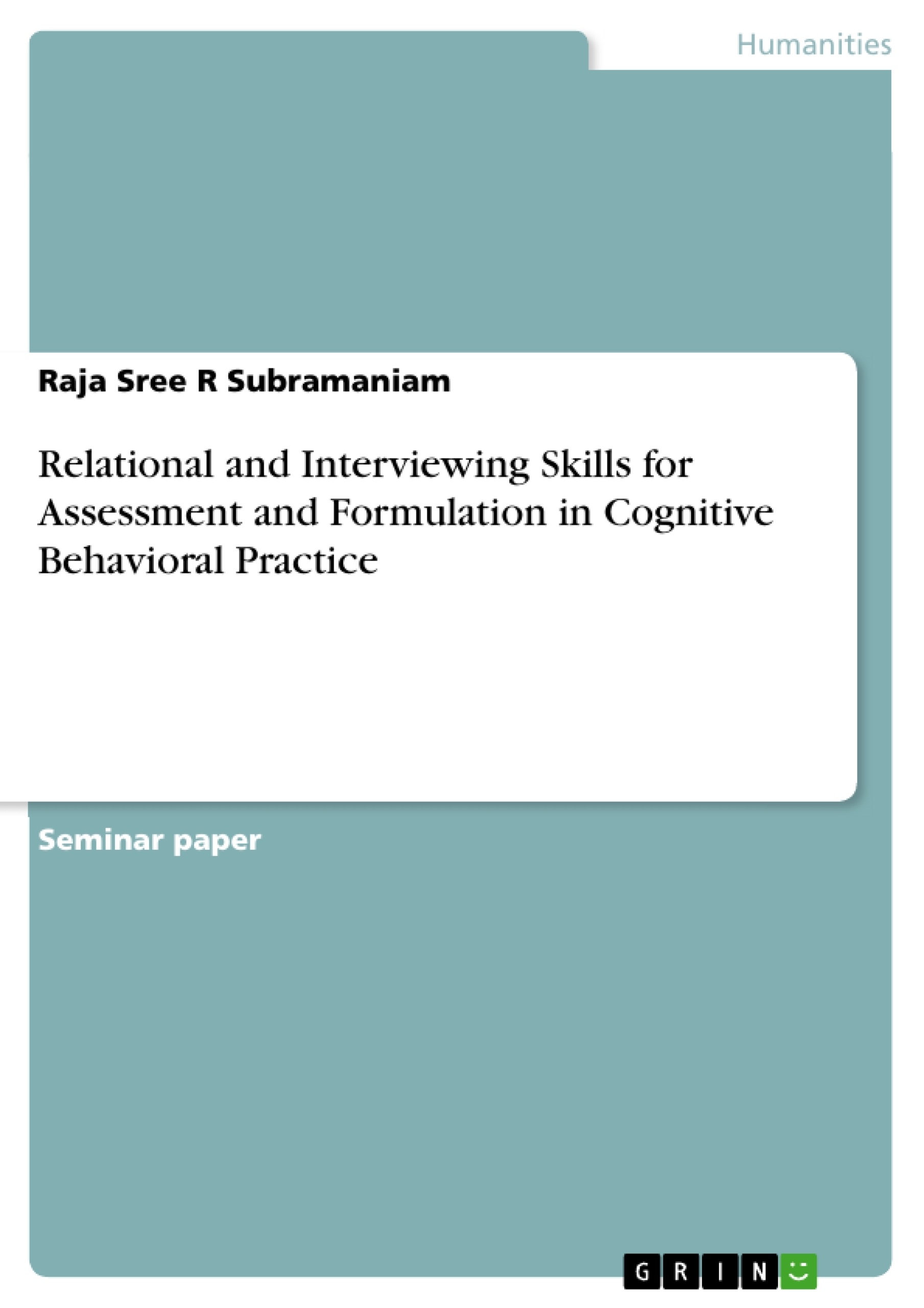This essay evaluates the therapist’s relational and interviewing skills in conducting CBT assessment critical in establishing, developing and maintaining a therapeutic relationship with the client.
Research suggested that therapist interpersonal skills facilitate therapy processes and good client-therapist collaboration. Therapeutic relationship is a helpful and positive relationship, whereby a client is reliant on the therapist’s help. The helper relational skills include empathy; genuine, receptive, good communicator and can reflect client’s feelings and thoughts accurately without prejudice. In a person-centered approach, the therapist creates therapeutic conditions based on cognitive behavioural therapy (CBT) framework and evidence based treatment models. Unlike other talking therapies, the person-centered CBT instills client’s collaboration and determination in making choices about the therapeutic process.
The declarative, procedural and reflective (DPR) model provides theoretical guidelines for CBT therapists important in acquiring and maintaining the technical and relational skills throughout their profession. The DPR framework is an information-processing model, within which interpersonal flexibility, conceptual knowledge and technical skills are core components vital in establishing developing and maintaining a therapeutic relationship with the client. Client-therapist inter-personal variables, perspectives about CBT and cultural differences risk causing ruptures in the collaborative efforts.
Hence, a good interviewing skill that conveys empathy, congruence and unconditional positive regard can be used to clarify underlying problems, build confidence, trust, commitment to therapy and motivation to carry out CBT tasks and treatmen. Reflective practices and Socratic supervision help therapists to identify their strength, limitations and respond effectively.
Inhaltsverzeichnis (Table of Contents)
- Introduction
- The Client
- Establishing a collaborative relationship
- Unconditional Positive Regard
- Empathic Listening
- Open-Ended Questioning
- Close-Ended Questioning
- Clarification Questioning
- Paraphrasing and Reflecting Meaning
- Self-Disclosure
- Information Giving Response
- Summarizing statements
- Paraphrasing and Reflection of Feelings
- Transference and Counter-Transference
- Attending Skills
- Summary of Therapist's Performance
- Recommendations
- References
Zielsetzung und Themenschwerpunkte (Objectives and Key Themes)
This essay evaluates the therapist's relational and interviewing skills in conducting CBT assessment, crucial for establishing, developing, and maintaining a therapeutic relationship with the client. It focuses on the therapist's application of various techniques within the Cognitive Behavioral Therapy (CBT) framework, emphasizing the importance of empathy, unconditional positive regard, and active listening for successful therapy outcomes. The essay explores the significance of collaborative empiricism in CBT and the role of therapist-client interaction in creating a supportive and trusting environment.
- Importance of therapist's relational and interviewing skills in CBT
- Establishing a collaborative relationship between therapist and client
- Role of unconditional positive regard in building trust and acceptance
- The significance of empathic listening and active questioning techniques
- Benefits of using open-ended and closed-ended questioning in therapy sessions
Zusammenfassung der Kapitel (Chapter Summaries)
- Introduction: This chapter introduces the importance of therapist interpersonal skills in facilitating therapy processes and client-therapist collaboration. It discusses the key elements of therapeutic relationships, including empathy, genuine communication, and the ability to reflect the client's feelings accurately. The chapter further introduces the person-centered approach in CBT, emphasizing the client's active involvement and collaborative efforts in the therapy process. The DPR model, which provides a framework for acquiring and maintaining essential skills, is also discussed.
- The Client: This chapter describes the client's presenting problem, which is anxiety related to work performance. The client experiences a loss of confidence following a negative presentation experience and believes performance anxiety is hindering her career advancement.
- Establishing a collaborative relationship: This chapter focuses on the therapist's efforts to establish a collaborative relationship with the client. The therapist utilizes the CBT framework and introduces the assessment process to the client, emphasizing the importance of shared goals and working together towards achieving them. It highlights the significance of a strong therapist-client alliance in promoting positive change and treatment outcomes.
- Unconditional Positive Regard: This chapter examines how the therapist conveys unconditional positive regard to the client. By showing genuine interest and respect, the therapist gathers detailed information about the client's concerns, expectations, intentions, motivation, and hope for change. The chapter emphasizes the importance of non-judgmental communication in fostering trust and facilitating goal negotiation.
- Empathic Listening: This chapter focuses on the therapist's ability to engage in empathic listening. Through active questioning and responding techniques, the therapist demonstrates understanding and empathy towards the client's distressful experiences. The chapter highlights the benefits of empathic listening for both the client and therapist, including fostering a sense of safety, promoting client-therapist alliance, and reducing premature judgments.
- Open-Ended Questioning: This chapter explores the therapist's use of open-ended questioning to encourage client participation and promote collaborative discussion. By asking open-ended questions, the therapist guides the client through a discovery process, allowing them to analyze underlying assumptions and reach their own conclusions. The chapter discusses the benefits and limitations of open-ended questioning in therapy.
- Close-Ended Questioning: This chapter examines the therapist's use of close-ended questions to gather precise information. While effective for focusing on specific aspects of the discussion, over-reliance on close-ended questions can limit client participation and information sharing.
- Clarification Questioning: This chapter highlights the therapist's use of clarification questioning, followed by appropriate periods of silence, to encourage the client to elaborate on their story and provide further details.
Schlüsselwörter (Keywords)
The key focus of this essay lies in the application of Cognitive Behavioral Therapy (CBT) techniques in a therapeutic setting, particularly emphasizing therapist relational and interviewing skills. The essay explores concepts such as collaborative empiricism, unconditional positive regard, empathic listening, open-ended and closed-ended questioning, and the significance of building a strong therapist-client relationship for successful treatment outcomes.
- Quote paper
- Raja Sree R Subramaniam (Author), 2016, Relational and Interviewing Skills for Assessment and Formulation in Cognitive Behavioral Practice, Munich, GRIN Verlag, https://www.grin.com/document/322709



